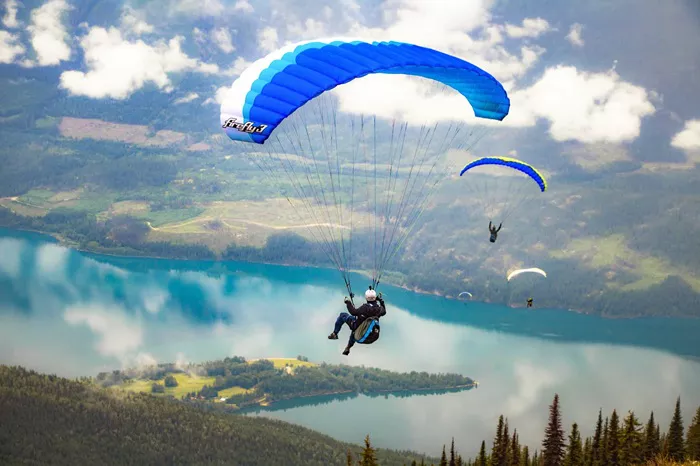Paragliding is an exhilarating sport that allows individuals to soar through the skies, experiencing the freedom of flight. However, safety is paramount in this extreme sport. Understanding the different types of paragliders and their safety features can significantly enhance the flying experience. This article outlines the seven safest types of paragliding, ensuring enthusiasts can enjoy their adventures with peace of mind.
1. EN-A Certified Paragliders
EN-A certified paragliders are the safest option available, designed specifically for beginners and occasional pilots. They offer the highest level of passive safety, which means they are very forgiving of pilot errors and sudden weather changes.
Key Features:
High stability and ease of control.
Designed to handle minor turbulence effectively.
Ideal for learning and gaining confidence in the air.
These paragliders are not only suitable for beginners but also provide long-term value for those who fly infrequently. With an EN-A wing, pilots can enjoy decent speeds while feeling secure.
see also: How Much Does a Paragliding Course Cost?
2. EN-B Certified Paragliders
As pilots gain experience, they often transition to EN-B certified paragliders. These wings allow for slightly higher speeds while maintaining stability and control.
Key Features:
Enhanced maneuverability compared to EN-A wings.
Suitable for cross-country flying (XC) and thermalling.
Still relatively forgiving, making them a good choice for intermediate pilots.
EN-B wings are a popular first upgrade for new pilots, offering a balance between performance and safety.
3. Tandem Paragliders
Tandem paragliding involves two people: a pilot and a passenger. This type of flying is not only safe but also provides an excellent introduction to the sport for beginners.
Key Features:
Larger wings designed to carry more weight.
Enhanced stability and resistance to collapse.
Ideal for those who want to experience paragliding without prior training.
Tandem flights are typically conducted by experienced instructors, ensuring that safety protocols are strictly followed.
4. Mountain Flying Paragliders
Mountain flying paragliders are specifically designed for soaring in mountainous regions. They incorporate features that enhance performance in thermals and ridge lift conditions.
Key Features:
Robust construction to withstand turbulent mountain air.
Excellent glide ratios for efficient soaring.
Designed to provide stability even in challenging conditions.
These paragliders allow pilots to navigate mountainous terrains safely while enjoying breathtaking views.
5. Acro Paragliders
Acro paragliders are built for acrobatic maneuvers but also prioritize safety features that make them suitable for experienced pilots looking to explore advanced flying techniques.
Key Features:
Reinforced structures to handle high-stress maneuvers.
Enhanced control during complex aerial tricks.
Designed with safety in mind, including features that minimize the risk of collapse.
While acro flying involves risks, using specialized equipment can mitigate these dangers, making it one of the safer options for skilled pilots.
6. Cross-Country (XC) Paragliders
Cross-country paragliders are designed for long-distance flights and offer a blend of performance and safety. They allow pilots to travel significant distances while maintaining control.
Key Features:
High glide ratios for efficient long-distance travel.
Stability in various weather conditions.
Suitable for intermediate to advanced pilots who want to explore beyond local sites.
These wings are engineered to handle diverse thermal conditions, making them a safe choice for adventurous pilots.
7. Speed Wings
Speed wings are smaller than traditional paragliders and designed for speed flying, which combines elements of both paragliding and skiing or snowboarding.
Key Features:
Compact design allows for quick launches from slopes.
High-speed capabilities with excellent maneuverability.
Requires advanced skills but offers thrilling experiences with safety features built-in.
While speed wings can be riskier due to their nature, they are equipped with safety mechanisms that help manage potential hazards effectively.
Safety Tips for Paragliding
Always check weather conditions before flying.
Use proper equipment, including helmets and harnesses.
Ensure thorough pre-flight checks on your gear.
Take lessons from certified instructors if you’re a beginner.
Stay informed about your environment and potential hazards.
By prioritizing safety through informed choices about equipment and practices, paragliding can be a rewarding adventure that many can enjoy safely over time.
Conclusion
Choosing the right type of paraglider is crucial for ensuring a safe flying experience. Each type outlined above offers unique benefits tailored to different skill levels and flying preferences. By selecting an appropriate paraglider and adhering to safety guidelines, enthusiasts can enjoy the thrill of flight while minimizing risks associated with this exciting sport.
Related topics:
- What is Acro Paragliding?
- Which Extreme Sport Is a Variation of Paragliding?
- How Much Does It Cost to Go Paragliding in Manali?

